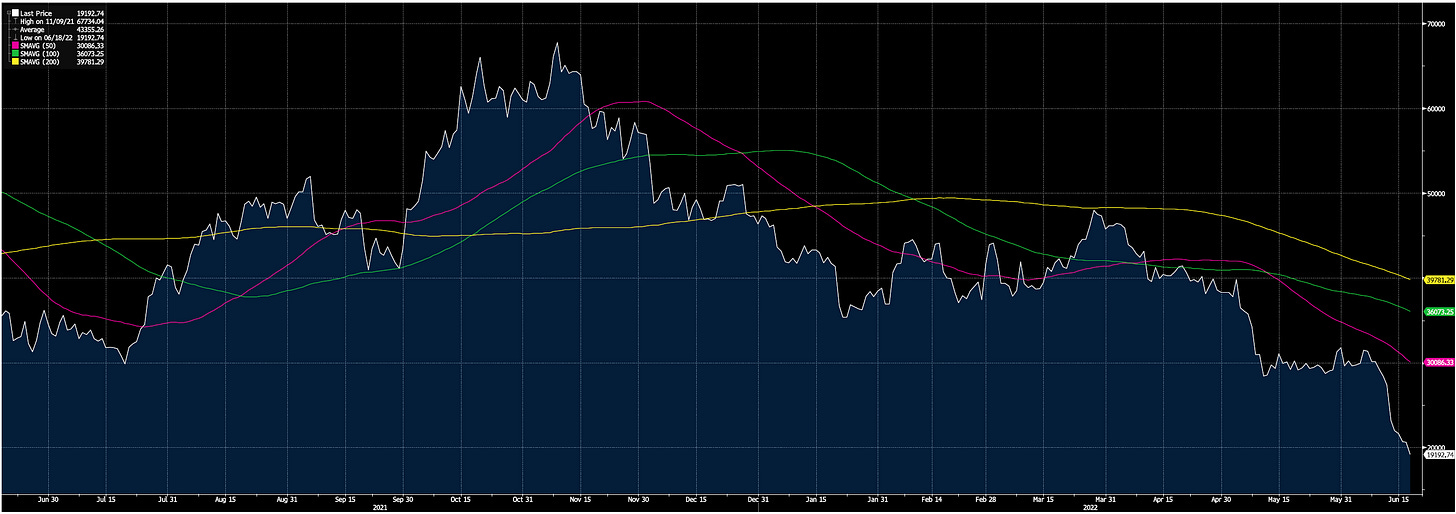Crypto: A Fearful Future
Is the hype over?
Turmoil has followed the cryptocurrency market over the last few months, seeing a fall in value of the largest cryptocurrencies from $3.2tn in November 2021 to below $1tn in June 2022. Notably during this period, Bitcoin saw a 70% decline in its price from the all-time high in November, shown below.
Ethereum (ETH) is also down, following a similar trend to Bitcoin. The once safe-haven new digital assets have now been battered down and their future as a reliable asset has been put into question.
Why are Cryptocurrencies Falling?
Just like with any other asset, it is never a singular reason that causes a market movement. We can identify a couple key reasons behind this decline with cryptocurrencies as follows:
Collapse of Terra Network, a widely used stablecoin, in May 2022 following a bank run on its assets, decreasing confidence for investors in other cryptocurrencies
Announcement by Celsius Network on 12 June 2022 to block customer withdrawals, a surprising shock to investors
General low investor sentiment following sell-off in equity markets
Sharp monetary policy tightening globally (FED = +75 basis points, BOE = +25 basis points, SNB = +50 basis points, ECB announced it will +25 basis points in July 2022)
Inflationary pressures globally
Celsius recently announced it would halt consumers from withdrawing funds, which has sparked fear in many investors, one of the drivers of the 28% 7-day decline in Bitcoin this week. General stock market movements are largely shadowed by crypto movements, and so in an unprecedented decline in stocks, it would follow suit that cryptocurrencies also are performing worse.
Bitcoin
Bitcoin is the largest cryptocurrency and has fallen significantly as shown above.
A particular metric used to judge the strength of Bitcoin is the "realised price", which is the average price of every bitcoin in supply, valued at the last time it was spent on the blockchain. In other words it represents the average price paid by buyers of bitcoin for coins in circulation.
Currently this stands at $23,430, and since the price of Bitcoin is currently below that, it shows the average buyer is making a loss on their holding.
The plummeting of prices is likely to cause further spirals, particularly as traders are forced to sell assets to meet collateral demands and margin calls.
El Salvador
Currently only 2 countries in the world allow for cryptocurrency as a legal tender. These include the Central African Republic (since 23 April 2022) and El Salvador (since 9 June 2021).
For El Salvador, the world's most crypto-friendly country, the fall in Bitcoin comes as a significant challenge, on top of the debt crisis it currently faces. For its 2,301 Bitcoin, it has seen the value of these investments more than half in size, from $105m to $51m. This is surprising for a country of which only 1/4 actually support the cryptocurrency as a legal tender; most still prefer the dollar.
While this scheme was pushed for by crypto-advocate and president Nayib Bukele, targeting the large unbanked population in El Salvador, to empower and reach them, it seems a larger educated population is needed to fully utilise the cryptocurrency and this may be why it has not been as popular. Equipping the population with the knowledge on how to operate with cryptocurrencies will certainly provide a more favourable outcome.
Conclusion
There may be some comfort to the fact that crypto is not tied to debt. Crypto is rarely used for collaterised debt, and so a crash in cryptocurrency, such as Bitcoin or Ethereum may not be detrimental to the economy as a whole. In addition, many experts refer to the idea of decentralisation as a benefit, in the sense that if there is a fall in Bitcoin, it is the same loss for an American investor as it is for a French investor. The losses are consistent everywhere, minimising regional disparages, commonly seen with fixed income and equities trading.
However, having said this a loss is a loss, and will be felt everywhere, no matter how much the individual differences can be offset. And it seems the average investor is feeling the losses at the moment across the board. Is the crypto-high once and for all gone?


